Serbian food will never leave you hungry! Below, we explore a few Serbian dishes to try while enjoying your vacation in Serbia. From hearty stews to filo pastry treats, we’ve covered the most famous types of dishes to try in Serbia.
The ones we cover are:
- Ajvar
- Baklava
- Bečka Šnicla
- Burek
- Ćevapčići
- Čvarci
- Fiš Paprikaš
- Gibanica
- Karađorđeva Šnicla
- Krofne
- Mućkalica
- Palačinke
- Pečenje
- Pljeskavica
- Podvarak
- Popara
- Prebranac
- Proja
- Punjene Paprike
- Rakija
- Roštilj
- Sarma
- Skembici
- Srpska Salata
- Uštipci
- Vanilice
- Urnebes
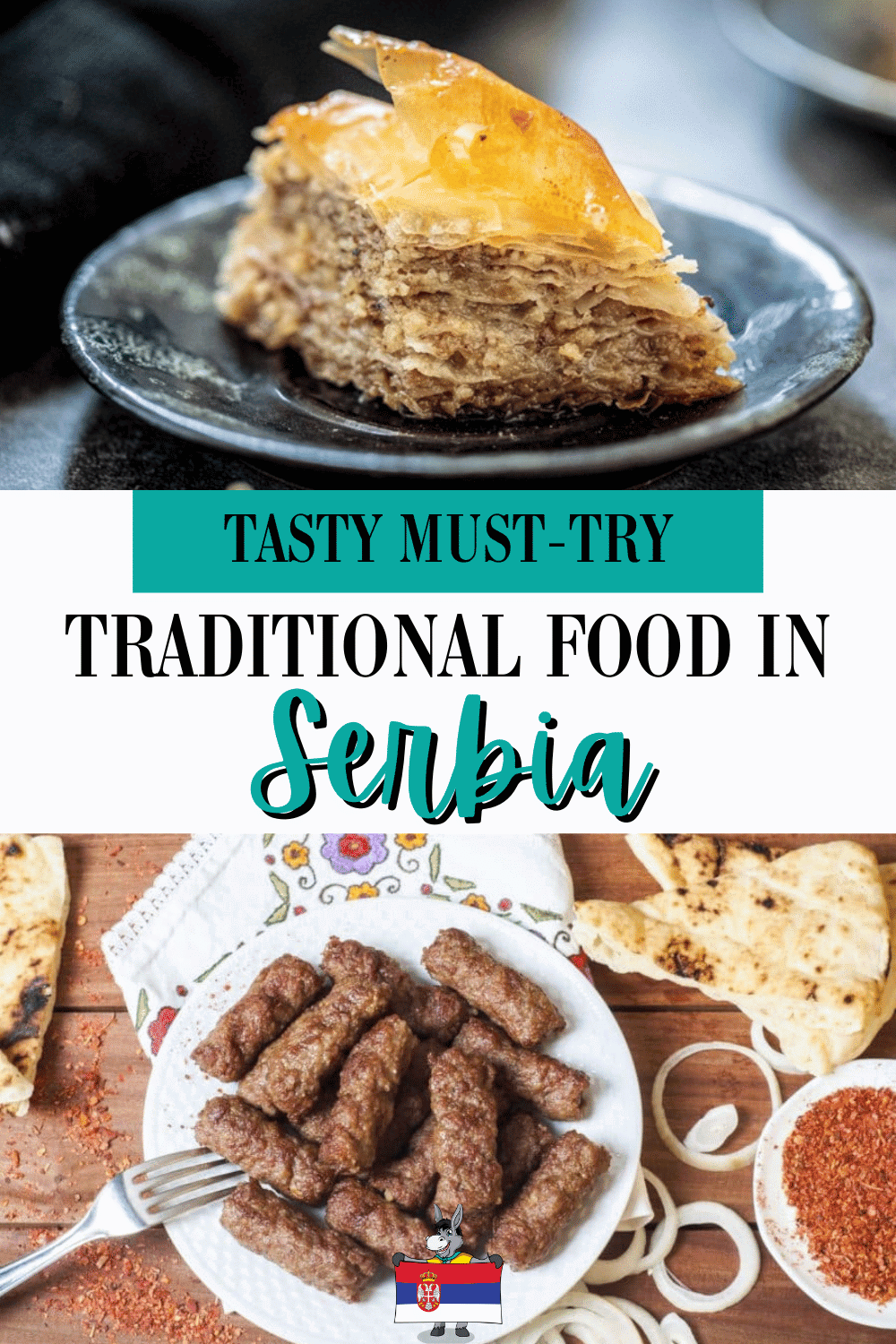
Skip Ahead To My Advice Here!
Traditional Serbian Food To Eat In Belgrade And Beyond
Traveling the world is not about just seeing sights and perhaps learning a few words of the local language. It’s also about tasting the food by sampling traditional cuisine.
Culture is about gastronomy, and in the Balkans, there are plenty of authentic and traditional dishes to try. When looking at what is Serbian food, I noticed that Serbian national dishes overlap with those of neighboring countries. There are, however, subtle differences to explore.
Serbian food has had many influences throughout the years, reflected in typical Serbian meals. These influences have made Serbian cuisine a real melting pot (pun definitely intended) of delicious flavors for the taste buds.
Influences ranging from oriental to many parts of Europe, Serbian cooking has its roots in meat, making it a hearty choice for colder days. Still, most Serbian traditional foods include many vegetables.
Pastry is also quite prevalent in the Serbian diet. So, when you combine that with meat, you certainly will not starve. But that’s okay, of course; there are loads of things to do and see in Serbia, from Belgrade to Novi Sad, to keep you busy and help you burn off those extra kilojoules.
Let’s explore the wonders of Serbian cuisine to give you an idea of what you can expect to see when traveling around Serbia and the best Serbian foods to try. Let’s take a look at what to eat in Serbia! This list of delicious foods from Serbia will prepare you to rent your car and road trip the country for yourself to eat!
Traditional Serbian Dishes – Serbian Snacks & Appetizers
Let’s run through our favorite Serbian traditional food choices we think you’ll love:
1. Čvarci
If you love pork crackling, this dish is for you. Cvarci is often prepared towards the end of summer into autumn, and it’s enjoyed as an ingredient in a full meal or a snack.
2. Ajvar
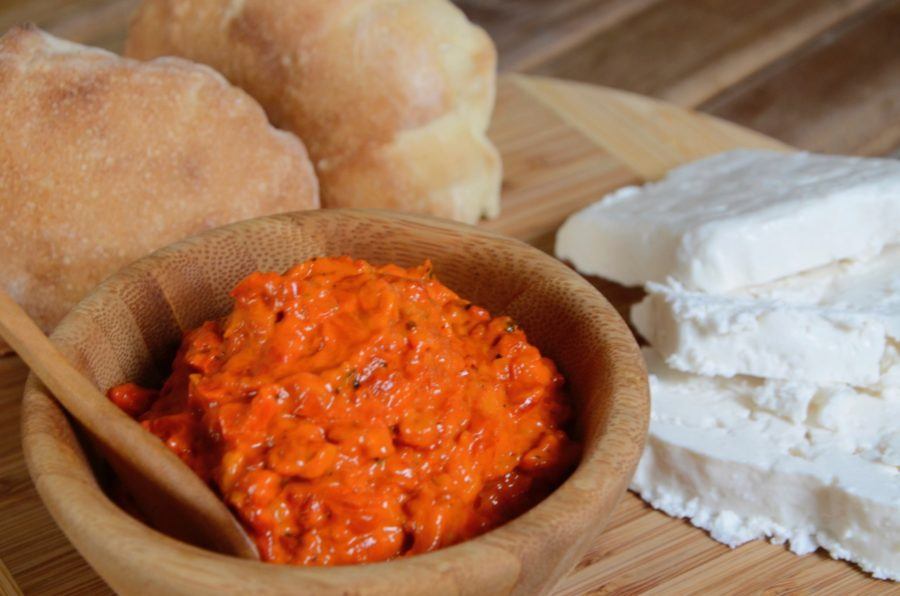
A Serbian red bell pepper spread, ajvar (pronounced: i-var), is a traditional dish in Serbian cuisine that’s also popular in other Balkan countries and even the world. It is eaten in various ways, including a spread on bread, salad, or dish with fish or meat.
Ajvar is super easy to make at home, and the recipe does not call for anything other than red bell peppers, eggplant, garlic, olive oil, salt, and pepper. After the bell peppers and eggplant are roasted in the oven or on the grill, all the ingredients are blended to form a paste or relish. For different touches of flavors and heat, you can add a little bit of tomato paste, roasted red onions, and/or chili flakes as well.
This traditional Serbian dish is fantastic, such as a dip with toasted pita bread or a side dish with roasted and grilled meat or fish.
3. Gibanica
This is a Serbian pastry dish that is often enjoyed on the go as a snack. It is a white cheese pie made like the regional favorite burek. Layers of thin dough are filled with delicious and quite strong cheese, which is then glazed with egg to give it a golden color.
Serbian Food From Meat & Fish
4. Serbian Ćevapi – Mince Meat Skinless Sausages
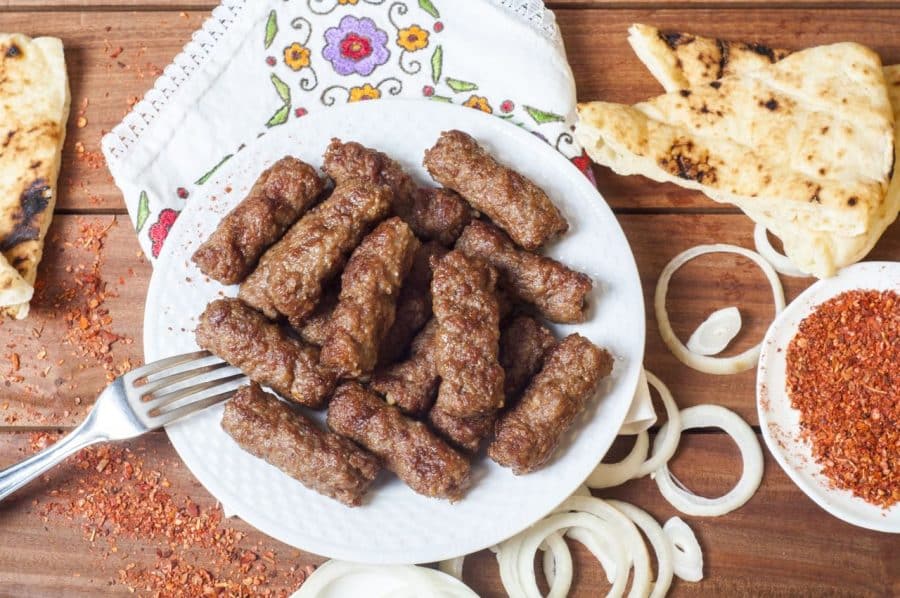
You’ll find cevapcici or cevapi all over the Balkans, from Croatia to Romania. These delicious, small sausages are made of minced and grilled meat. The meat is usually either pork, beef, or lamb, but it can also be a mixture.
You will often get a portion of around 5-10 different sausages served on a fresh flatbread with onions, red pepper relish, and sometimes sour cream, too, if you want. This common and relatively cheap Serbian street food is often enjoyed by locals in Belgrade. is available at most takeaways, so try it.
5. Pljeskavica – National Dish Of Serbia
Very similar to cevapcici, pljeskavica is a patty type of food and is usually made with a mixture of pork or beef and a real spicy kick to boot. You’ll find it served on bread, with onions, like a Serbian hamburger. The patty itself is mixed with a type of milky cream and pepper sauce.
This is another very easily found type of street food and is actually one of the most popular Serbian snacks you’ll find – some refer to it as the Serbian national dish. It’s cheap and cheerful, and because of the amount of meat in it, it’s also very filling.
If you’d like to try Serbian meat dishes, you will have no trouble finding this one.
6. Sarma – Sour Cabbage Roll
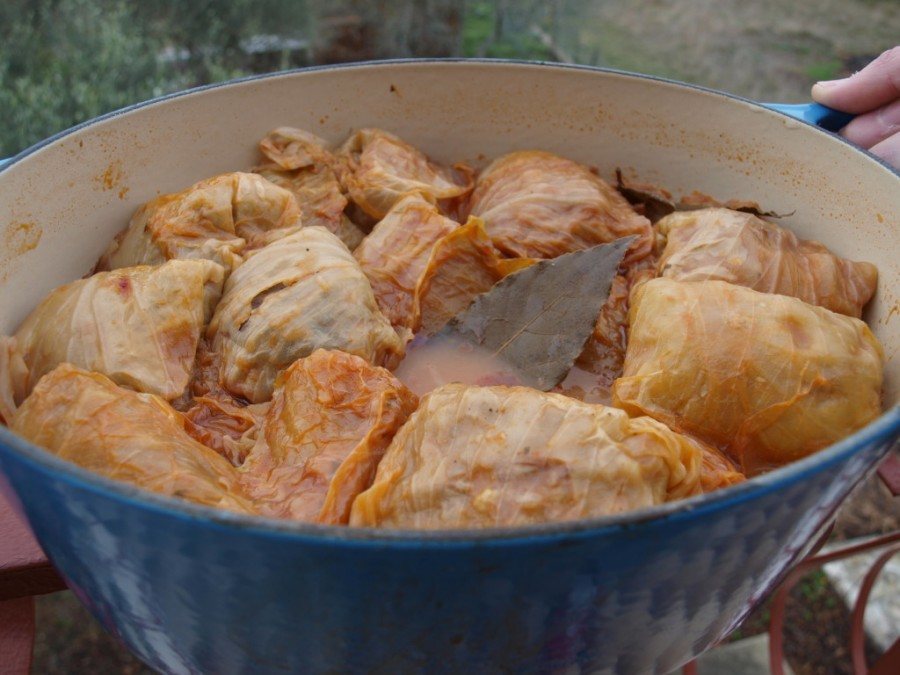
Sarma has many variations around the Balkan region, but as a portion of traditional Serbian food, it is usually a type of ground beef (minced meat) and mixed with rice.
The mixture is then wrapped in a cabbage leaf ( or grape vine leaf. This is then simmered and served with several side dishes, often including sour cream. You’ll find many traditional households serving sarma; it is much more hearty and filling than you might think from looking at it!
7. Roštilj
Rostilj can be made with different types of meat, but it’s usually cooked over an open grill to give that barbecued taste. You’ll often see it served with fresh bread and salad, and it’s the ideal dish for true meat lovers.
8. Pečenje
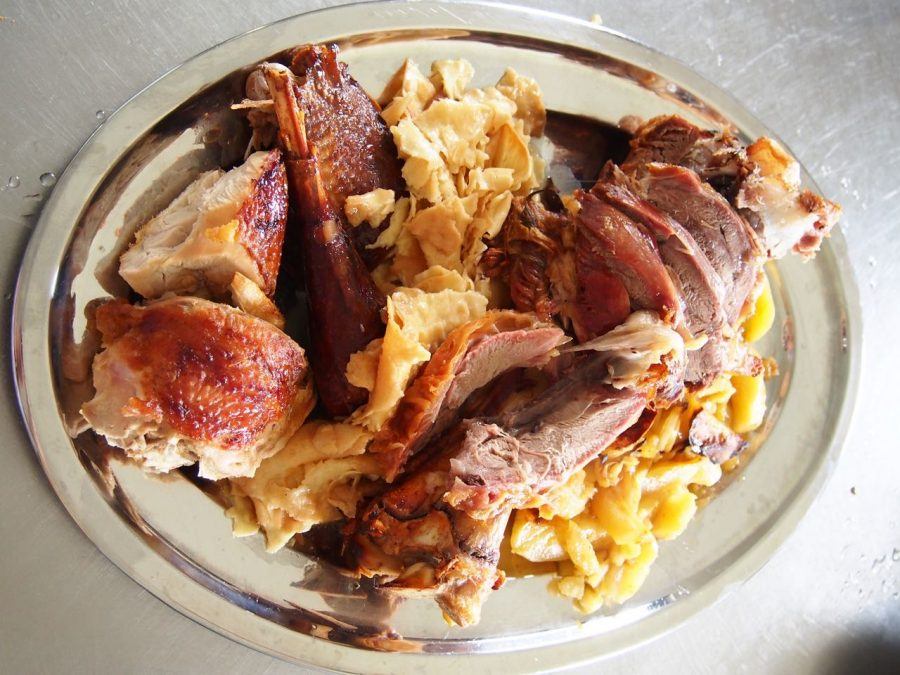
Its name means roasted meat; you’ll usually find pečenje in various forms in the country. This is one of the absolute must-have traditional Serbian dishes at big celebrations, such as weddings. Pečenje is usually a whole roast pork joint, an entire lamb joint, or even goat, depending on your preference, and comes with various side dishes.
It is commonly served in thick slices and in great abundance, so expect to be stuffed after a meal of this famous Serbian food!
9. Bečka Šnicla
This particular Serbian dish is better known as the “Viennese schnitzel.” Actually hailing from Austria, it has become very popular across the continent and throughout the Balkans.
It is boneless meat that is hammered until thin, coated in breadcrumbs, and deep-fried. This yummy Serbian food is often served as a main meal, usually with potatoes and butter and garnished with parsley.
10. Fiš Paprikaš
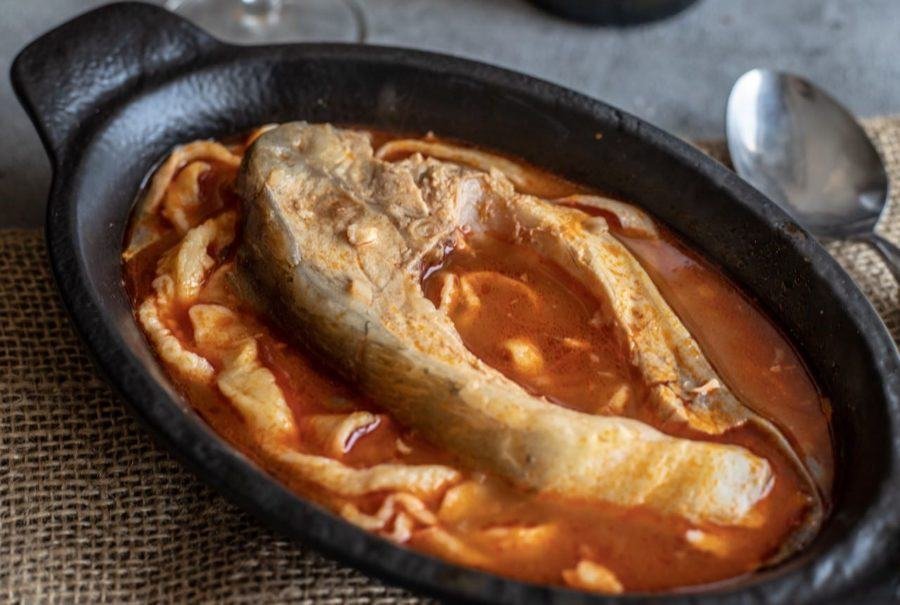
Seafood is quite popular in Serbia, and if you are in a local seafood restaurant, you should definitely try this delicious fish stew for your authentic Serbian dinner. Even if you’re not a fish lover, you’re encouraged to give this a go. It’s a super popular Serbian food for a reason.
It’s not overly ‘fishy’ but has a very fresh flavor. The stew consists of paprika and tomato juice with a spicy kick.
11. Podvarak
Podvarak is another dish you’ll see widely throughout Serbia, and it’s made with garlic, onions, meat, and sauerkraut. It’s usually made with pork or chicken, but you can make a meat-free version too.
This is another meal that’s often served when it’s cold outside, as it’s hearty and warming. You’ll also see it served with fresh bread.
12. Karađorđeva Šnicla
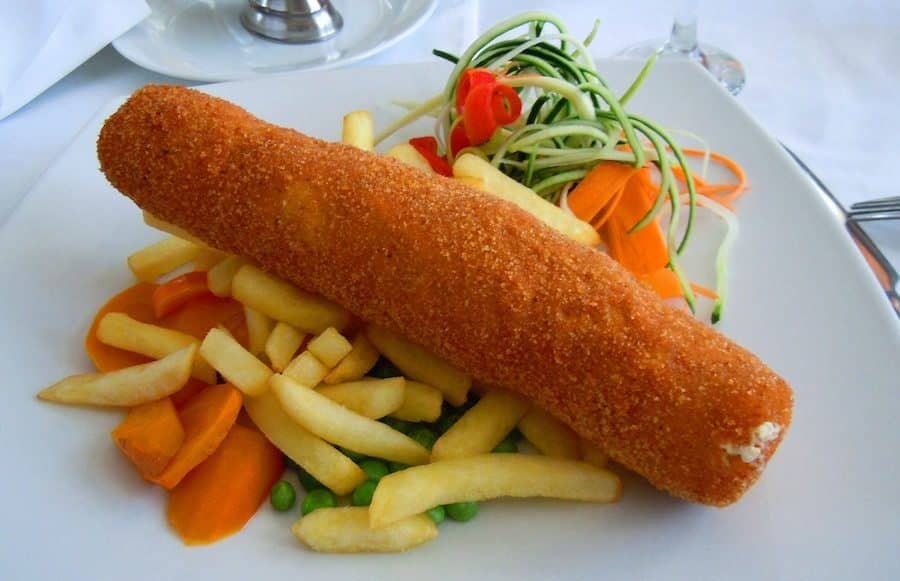
Another of those Serbian meals with a meaty punch is a steak dish of either rolled pork or veal steak.
It is stuffed with kajmak, which is like clotted cream, and then breaded and cooked, usually fried or baked. Once served, it usually comes with potatoes and tartar sauce.
When cooked, the kajmak in the middle turns into a creamy sauce, making the meat super-succulent. Delicious!
13. Skembici
Perhaps not for those with a weak stomach, skembici is a very old Serbian dish, considered one of the authentic Serbian delicacies by locals. It is a tripe soup. Yes, really.
Tripe is served in a stew made of various vegetables and herbs. It is usually served alongside boiled potatoes for a really filling and hearty dish. Tripe soup is also found in neighboring countries, and if you want to try something new and traditional, this is the dish.
14. Punjene Paprike
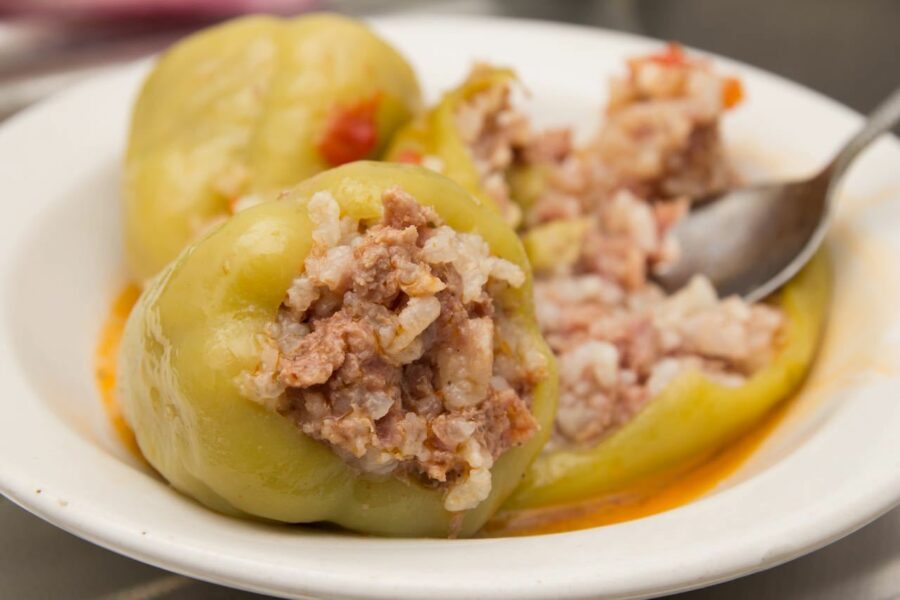
Paprika is very commonly found in Serbia, and this is a stuffed paprika dish. It is loaded with a combination of different meats, rice, tomato sauce, egg, spice, and red capsicum to give it a kick.
Again, it’s a very hearty dish but a somewhat healthy one at the same time. You’ll also find this common in many households at dinner time and in authentic Serbian restaurants.
15. Mućkalica
This dish is a winter staple in many homes as it can be made with meat left over from the day before. However, it’s typically made with bacon, roast pork, roasted peppers, tomatoes, onions, chili peppers, and paprika. It’s often served alongside ajvar and salad, with fresh bread as standard.
Brands We Use And Trust
Serbian Pie Dishes
16. Burek

Hailing from the eastern Balkans and Turkey, burek has become an established staple in the Serbian kitchen. The main ingredients in the delicious savory Serbian burek are layers of flaky phyllo pastry and ground meat, which can be beef, lamb, pork, or any combination of those three. Alternatively, you can use a mixture of cheese as a savory and creamy filling.
Burek comes in various shapes, from coils and cylinders to round pies, but it is traditionally cut into small squares. A mouthwatering Serbian dish, burek squares are eaten as appetizers, a filling snack, or even a main dish.
Vegetarian Serbian Cuisine
17. Urnebes
This is a top traditional Serbian salad served with many other main meals. It is widespread, though mainly found in the country’s south.
It is a salad of cream cheese, hot peppers, and a few other spicy treats. It is spiciest in the country’s southern reaches, where it hails from and can be slightly different from place to place in terms of mildness or otherwise.
18. Proja
This is a cornbread dish that dates back many years. This dish was popular when money was low and poverty was prevalent in the country. It was easy to make, cheap, hearty, and filling and didn’t spoil.
Despite times improving, you’ll still find proja in many households and traditional restaurants.
19. Prebranac
Prebanac is a staple dish in Serbia, particularly during the winter months. It’s quite heavy and hearty and is made with beans, garlic, paprika, onions, oil, and bay leaves. It’s a filling meal, and you’ll often see it served with warm bread for dipping.
20. Srpska Salata
You’ll often find this salad alongside other dishes or enjoyed on its own. It’s a combination of chopped cucumbers, tomatoes, peppers, and onions, and often served with cheese chopped up too. It’s similar to other regional salads, such as the one found in Bulgaria.
The salad is then served with oil, vinegar, salt, and pepper.
Serbian Desserts
Okay, enough about the savory Serbian foods—let’s explore the sweeter Serbian cuisine, which you can try in Serbia.
21. Baklava
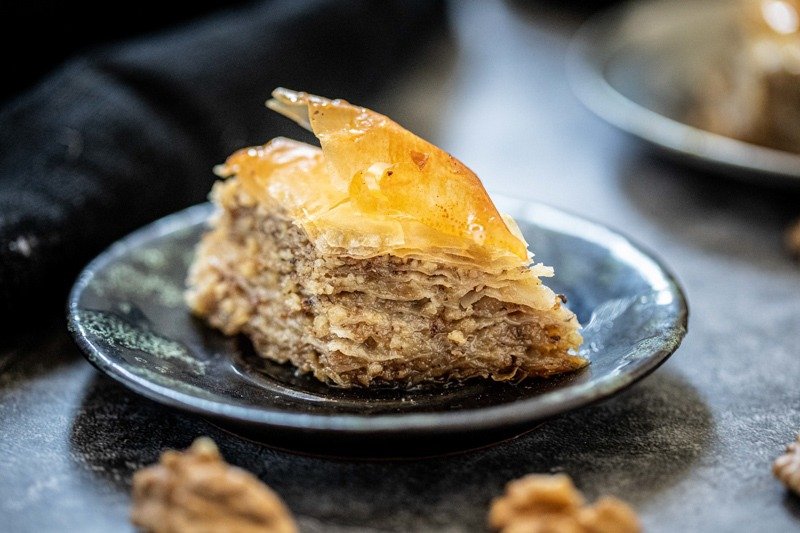
While not native to Serbia, you’ll find baklava all over the Balkans and all over the Mediterranean.
This sweet pastry is filled with chopped nuts and honey (which also happens to be a great souvenir to bring home) and usually sprinkled with pistachio nuts. It’s sticky, it’s sweet, and it’s filling (again), but you’ll definitely want more than one piece!
22. Popara With Kajmak
Popara is usually served as breakfast in Serbia. It is a quite heavy dish that will probably fill you up for the rest of the day.
This meal is made with bread, cheese, kajmak (the creamy milky ingredient we mentioned earlier), milk, and water. This is an accompaniment dish, rather a Serbian dish on its own, but it will certainly fill you up!
23. Krofne
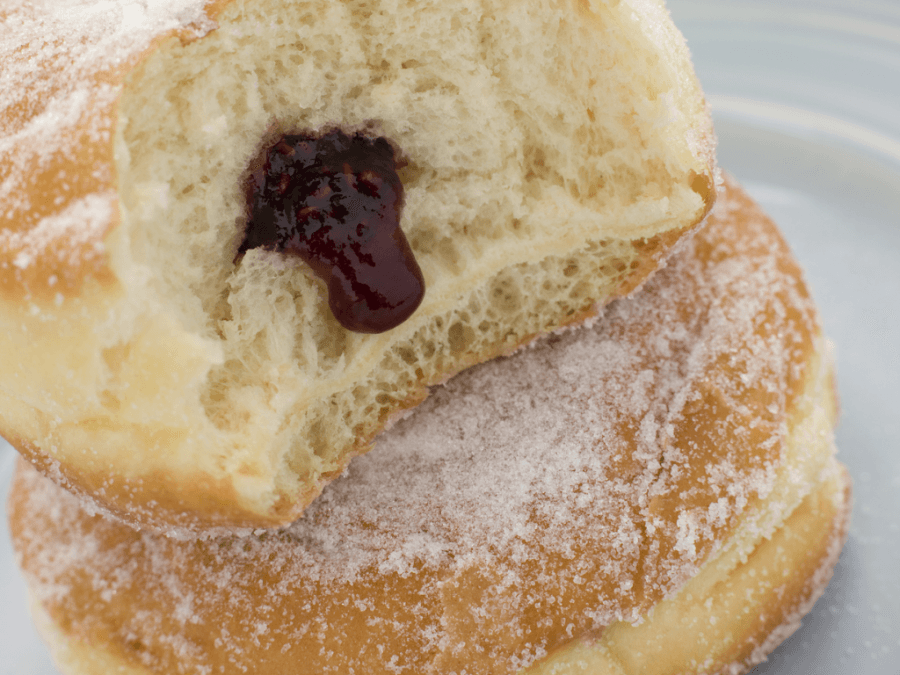
Krofne is a doughnut that can be filled with various ingredients, such as jam, chocolate, marmalade, custard, or cream. The most common filling is jam or chocolate; if you have a sweet craving, you can quickly grab and eat one on the go.
24. Uštipci
Like the krofne as mentioned above and Croatian fritule, uštipci are fried balls of dough that can be eaten for breakfast, as a mid-afternoon snack, as dessert, or even as a main course. Making them is somewhat easier than making krofne.
They also don’t necessarily have to be sweet, although popular fillings include jam, apple, and chocolate. Savory uštipci fillings range from pumpkin and cheese to meats.
25. Palačinke
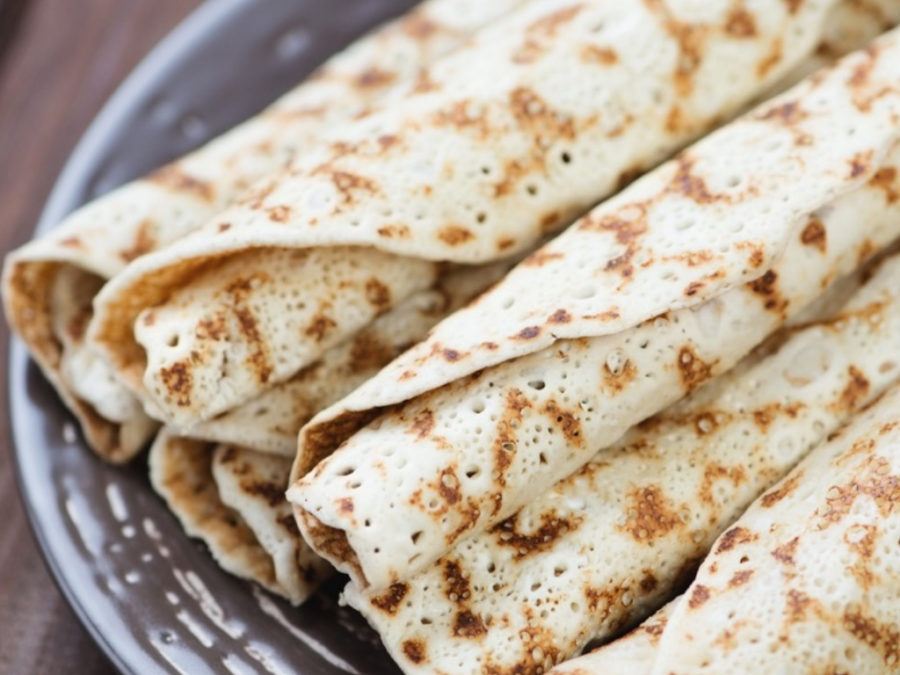
Again, you’ll find regional variations of palačinke all over the Balkans and Europe. The typical Serbian food version, however, is quite delicious! This is a crepe or pancake traditionally filled with cream, chocolate sauce, biscuits, walnuts, and sometimes honey.
You’ll easily find this traditional food in Serbia all over the place, either as street food in Serbia or in dedicated shops (that’s how popular they are). There’s also a savory version to try, which is often filled with cheese or ham.
26. Vanilice
If you love cookies, this treat is for you. You’ll often see vanilice around the winter months, particularly towards Christmas. It’s two vanilla and walnut cookies sandwiched together with jam in the middle. They’re then dusted with icing sugar and served to those who love a sugar rush!
I have some Serbian food recipes here if you want to make some of these at home.
Move This Adventure To Your Inbox & Get An Instant Freebie

No spam. Unsubscribe at any time.
Must-Try Serbian Drinks
27. Rakija – National Drink

Well, here we are. We have reached the end of this list of the best culinary experiences in Serbia. And what would this list be if it didn’t include the Balkans’ all-too-famous drink, Rakija?
Actually, Rakija may not be renowned enough worldwide, but it certainly is throughout Serbia and the rest of the Balkans. Everyone, everywhere (in the Balkans), drinks this delicious fruit brandy throughout the region and cultures – they usually spell it differently.
It is generally made from plums, which give it a naturally sweet taste similar to that of a good bottle of brandy. Though plums are only the beginning, almost anywhere you go, you will see endless choices of flavors, such as berries, apples, pears, peaches, herbs, nuts, and so much more beyond what you can imagine.
Every vacationer to the Serbia has their own rakija story of a night drinking one too many, and, believe us, and it can happen more straightforward than you think. This stuff goes down like water!
Serbian Food FAQs
What are the main influences on Serbian cuisine?
Due to Serbia’s geographical location, Serbian cuisine combines influences from Byzantine, Mediterranean, Central European, and Balkan cultures and the Middle East.
What is typically present in Serbian food?
Serbian cuisine primarily uses seasonal, high-quality ingredients. Staples include grilled meats, minced meat, fresh vegetables, bread, cheese, pastries, and wine.
What are the must-try dishes in Serbia?
- Ajvar
- Baklava
- Bečka Šnicla
- Burek
- Ćevapčići
- Čvarci
- Fiš Paprikaš
- Gibanica
- Karađorđeva Šnicla
- Krofne
- Mućkalica
- Palačinke
- Pečenje
- Pljeskavica
- Podvarak
- Popara
- Prebranac
- Proja
- Punjene Paprike
- Rakija
- Roštilj
- Sarma
- Skembici
- Srpska Salata
- Uštipci
- Vanilice
- Urnebes
What should one keep in mind when trying Serbian food?
Serbian dishes are robust, varied, and satisfying, but they can also be quite filling, especially for those not accustomed to heavy meat or starch meals.
As you can see, typical Serbian food won’t leave you hungry! These are just a few Serbian dishes to try while enjoying your vacation in Serbia. Let us know if you have another you’d like us to add.
So, now that you know all about the most popular dishes eaten in Serbian homes, which dish will you try first?
- Your Guide To Serbia Accommodation
- What To Expect On Your First Trip To Serbia
- Day Trips From Belgrade
- Things To Do In Belgrade
- Hiking Via Dinarica
- Best Souvenirs To Bring Home From Serbia
- A Guide To Bring Your Pet To Serbia.
- 7 Best Ski Resorts In Serbia
- Travel Itineraries For A Weekend Trip To Serbia
- Best Things To See & Do In Nis, Serbia


wow so delicious looking cuisine. The roasted meat and the best dish for the steak lover with both the tastes of meat and vegetables. Really love to eat these dishes
What a tasty guide, thanks for the culinary inspiration. Now if I could only find gibanica for my afternoon snack right now.
I found a super cool website where if you live in USA or Canada they ship all your favorite Balkan food products to your door. I’ll email you the name and you should share it.
Loved your blog. When I visit Serbia, I can glance through your blog and choose the Taste of Serbia that I would like to check.
Looking for Baba n Dead serbian dessert…(to me it sounded) Shanitza… I remember it being 100% grain finally chopped nuts I think she used a little alcohol talked with chocolate sprinkles
I think you are looking for Pšenica (in Serbian: “Пшеница”) pronounced Pshenitsa, also known as Жито / Žito / Zhito) or Кољиво / Koljivo /Kolyivo.
It is always prepared for the Patron Saint Day (SLAVA / СЛАВА ) and often served in our Church after certain Services. Given the abundance of wheat and other grains, many people would have it as a dessert any time.
For recipes (you will find many) Google “Slava zito recipe” or “Serbian Slava Zito”)
Good Luck/ Srechno
Awesome! Thanks so much for helping Misti dear George! You’re a real gem. Хвала вам.